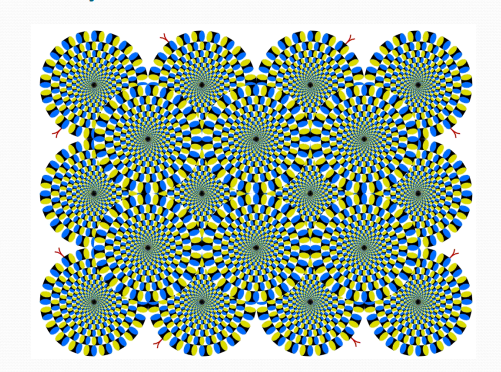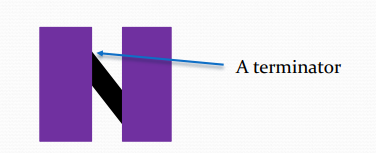Motion perception- week 10
1/20
Earn XP
Description and Tags
MBB1
Name | Mastery | Learn | Test | Matching | Spaced |
|---|
No study sessions yet.
21 Terms
Break Camouflage, Attract Attention, Segregate Objects
A camouflaged animal can be virtually invisible – until it moves.
When it moves, attention is attracted to it and its camouflage is broken!
So, motion attracts attention…
…and help us segregate objects from the background.
Interpret Events
Motion can also allow us to interpret events
By seeing how objects interact, you can infer causality relationships and even social relationships.
In the following video a large triangle gets into an argument with a small triangle and a small circle.
The large triangle chases off the other two shapes before destroying the house.
The entire story is conveyed using motion info
Structure From Motion
Motion can also allow us to infer structure
It can help us determine the shape of a moving object
This is sometimes referred to as the “kinetic depth effect”
In the following video the 3D shape of a number of objects will be revealed by their motion.
Note that when these objects are stationary, their 3D shape information is unclear.
Motion allows us to infer 3D shape
Interpreting Actions
Motion can also allow us to interpret actions
While static poses are often ambiguous…
…when someone moves, their actions and intentions are often made clear.
This phenomenon is typically demonstrated using point-light walkers
Point-Light “Walkers”
Point-light walkers are created by placing lights on a person’s joints and having them perform an action (e.g. walking!)
They are videoed so that only the lights can be seen.
Humans are so good at processing motion stimuli that they can guess what action the person was performing
Summary: Function of Motion Perception
Motion perception can
Help break camouflage
Help attract attention
Help segregate objects from the background.
Help us interpret events.
Help us determine the structure of objects
Help us determine what actions people are performing
Life Without Motion Perception
Sometime due to either disease or trauma, a patient will suffer damage to a part of the brain responsible for motion perception.
Consequently, the person may no longer be able to perceive motion.
This condition is known as akinetopsia.
Life Without Motion Perception- akinetopsia
Patient L.M. had akinetopsia
Consequently, L.M. had difficulties
Pouring a cup of tea
Crossing the street
Following speech
Essentially, L.M. could see that things had moved but couldn’t see them moving
Life Without Motion Perception - phenomena
While this may seem strange, we have all experienced this phenomenon.
For example, at the beach, you may have seen a ship on the horizon.
It may be so far away that it appears not to be moving.
But when you glance up a few minutes later, you are surprised to see that it has moved.
This is how L.M. experienced everyday life – she constantly discovered that things had moved but could not perceive them to moving
When Do We Perceive Motion?
Real motion (something actually moving)
Illusory motion (nothing actually moving)
Static image (e.g. rotating snakes illusion - Kitaoka & Ashida, 2003)
Apparent motion
Motion aftereffects
Induced motion
Moving background (or a moving object) causes a stationary object to appear to move

Rotating Snake Illusion
We don’t really know why this particular static illusion gives the impression of motion
Clearly, the percept of motion is caused by the contrast between the colours – but it is unclear why these contrast difference cause the percept of motion
For our current best guess, see Faubert, J. & Herbert, A.M. (1999). The peripheral drift illusion: A motion illusion in the visual periphery. Perception, 28, 617– 622
Apparent Motion
Apparent motion occurs when a series of stationary images are presented in succession to give the impression of motion.
For example, if I alternate between the two slides below, you wouldn’t see two separate dots.
Instead, you would see a single dot moving from left to right
Apparent motion works only if the dots are sufficiently close together
If they are too far apart and the alternation rate is too fast, motion perception ceases to occur.
Instead, the percept will be of two separate flashing dots
For apparent motion to occur, as separation increases alternation rate needs to decrease.
This is known as Korte’s Third Law of Apparent Motion (Korte, 1915)
Curiously, apparent motion is mostly insensitive to colour changes
However, colour can be used to disambiguate ambiguous apparent motion
In the following demonstration the green dot will appear to move from top-right to bottom left and back again

Motion Aftereffect
Image of Fall of Foyers near Loch Ness in Scotland where Robert Adams (1834) first experienced the waterfall illusion.
After staring at the waterfall for several minutes, he then shifted his gaze to the rockface which appeared to move upwards

Induced Motion
Induced Motion: A nearby object (usually a large one) either affects the perceived motion of a second object (usually a small one) or causes a second object to appear to move.
Motion Induced Blindness
Although motion can make things more visible (e.g. breaking camouflage), it can also cause things to disappear, as in motion induced blindness (Bonneh, Cooperman & Sagi, 2001)
Another motion-related phenomenon we don’t have a good explanation for
Motion can also make it harder to notice changes
In the following demo, when the dots are stationary, it is very easy to notice them changing colour.
When they move, it is much more difficult to notice that they change colour
Motion induced blindness - how it works
Normally colour changes attract attention because of the transient signals associated with the change (i.e. the “flicker”)
However, when things are moving, there are transient signals associated with all objects – not just the ones that are changing
Thus, attention is no longer drawn preferentially to the changing objects, so the changes are not noticed.
Motion Illusions
Motion illusions can inform us of the processes underlying motion perception
For example, the Footsteps Illusion shows us that contrast affects motion perception.
As the yellow and blue rectangles traverse the striped background, they appear to speed up and slow down asynchronously
Footsteps Illusion
Contrast at leading edge of yellow rectangle is low
Contrast at leading edge of blue rectangle is high
Contrast at leading edge of yellow rectangle is high
Contrast at leading edge of blue rectangle is low

Footsteps illusion shows us
The Footsteps Illusion shows us that contrast affects motion perception.
Higher contrast objects appear to move faster and lower contrast objects appear to move more slowly
This could explain why people often underestimate the speed of cars moving through fog…
…a phenomenon that sometimes causes accidents
Aperture Problem
If you can’t see the ends of a line, the movement of a line is ambiguous.
Consequently, the motion of the line viewed through an aperture is ambiguous and is “captured” by the movement of the terminators (the points where the line joins the aperture)
When the terminators move horizontally, the line appears to move horizontally.
When the terminators move vertically, the line appears to move vertically.
When we can see that actual ends of the line, we can see its

Barber Pole Illusion
Same principle applies in the Barber Pole illusion.
In this illusion, lines curve around a cylinder creating virtual terminators that move vertically.
Thus, the lines themselves appear to move vertically